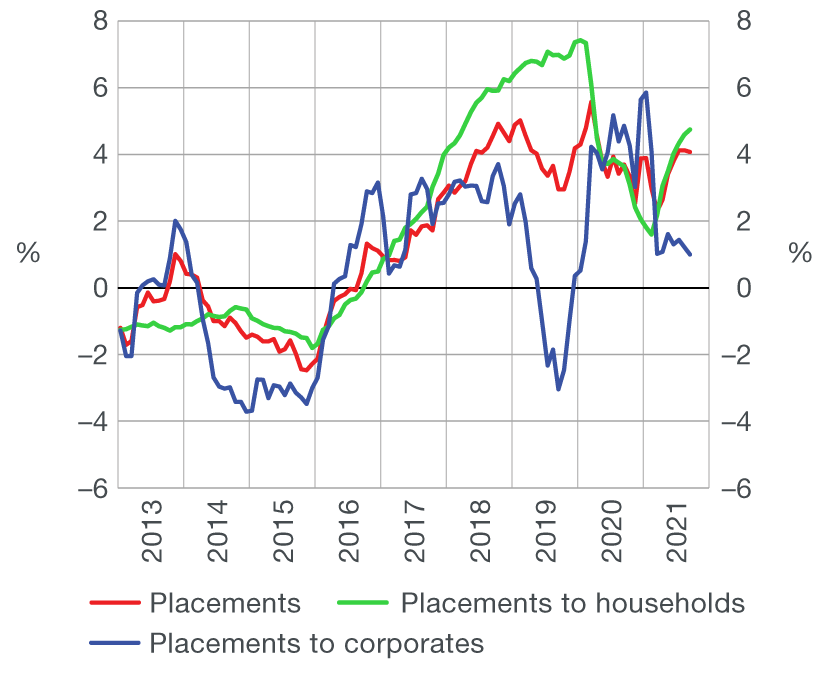From August 2023 the comments on statistics, a short description of selected, recently issued statistical data in the area of monetary statistics and the non-residents sector statistics, are no longer published. They are replaced by Statistical releases.
Comments on monetary developments for September 2021
Total liquid assets (M4) and money (M1) decreased slightly in September, but their growth rates edged up on an annual basis as a result of base effect.
Total placements of monetary institutions to domestic sectors (except the central government) also witnessed a mild monthly decrease, although placements to households increased due to a further rise in housing loans, as well as a resurgence of general-purpose cash loans.
Total liquid assets (M4[1]) fell by HRK 0.5bn (0.1%, based on transactions) at the end of September from the month before. Net domestic assets (NDA) declined sharply, with a strong rise in net foreign assets (NFA) of the monetary system (Table 1), which is mostly due to the inflow of foreign exchange from the European Commission’s pre-financing payment under the National Recovery and Resilience Plan to the government’s account kept with the CNB. Money (M1[2]) also went down by HRK 0.5bn (0.3%) in September, reflecting a fall in currency outside credit institutions at the end of the peak tourist season, whereas demand deposits witnessed a growth. Quasi-money increased slightly from the previous month, owing to the rise in foreign currency deposits of households and corporations, which was somewhat stronger than the drop in kuna deposits (Table 3). Despite the monthly fall, the annual growth rates of M4 and M1 accelerated from 11.1% and 19.8% in August to 11.4% and 20.7% in September, due to a more pronounced drop in these monetary aggregates in September last year (base effect) (Figure 1).
| Figure 1 Monetary aggregates annual rates of change based on transactions |
Figure 2 Placements annual rates of change based on transactions |
 |
 |
| Source: CNB. |
Total placements of monetary institutions to domestic sectors (except the central government) continued to decrease (by HRK 0.2bn or 0.1%, based on transactions) in September from the month before, ending the month at HRK 241.3bn. The annual growth rate of total placements remained unchanged at 4.1% for the third month in a row (Figure 2). The monthly drop in placements was driven by a decline in total loans (HRK 0.3bn or 0.1%), accounting for the largest share of placements. Loans to corporates decreased (HRK 0.7bn or 0.8%), and their annual growth rate edged down from 1.3% to 1.0%. On the other hand, loans to households grew by HRK 0.5bn or 0.3%, with the largest contribution to the increase in household lending still stemming from housing loans, which grew by HRK 0.4bn (0.6%), with a continued resurgence of general-purpose cash loans (HRK 0.3bn or 0.6%) (Table 2). On an annual level, the growth of housing loans continued to accelerate, from 10.8% in August to 11.2% in September, as was the case with general-purpose cash loans (from 0.8% to 1.3%), resulting in an acceleration of the growth of total loans to households, from 4.6% to 4.8%.
Table 1 Summary consolidated balance sheet of monetary institutions
in billion HRK and %

1The sum total of asset items 2.2 to 2.8 of Bulletin Table B1: Consolidated balance sheet of monetary financial institutions.
2The sum total of liability items 2 to 5 of Bulletin Table B1: Consolidated balance sheet of monetary financial institutions.
Source: CNB.
Table 2 Loans (except the central government) and main components
in billion HRK and %

1 In addition to loans to households and corporates, they also include loans to the local government and other financial institutions.
2 The transactions show changes that exclude the effects of exchange rate changes, securities price adjustments, reclassification and write-off of loans, including the sale of loans in the amount of their value adjustment.
Source: CNB.
Table 3 Deposits (except the central government) and main components
in billion HRK and %

1 Includes only kuna sources of funds of credit institutions.
2 The transactions show changes that exclude the effects of exchange rate changes, securities price adjustments, reclassification and write-off of loans, including the sale of loans in the amount of their value adjustment.
Source: CNB.
For detailed information on monetary statistics as September 2021, see:
Central bank (CNB)
Other monetary financial institutions
